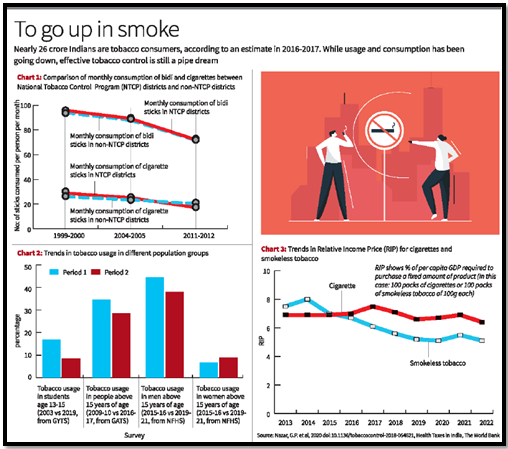THE TOBACCO EPIDEMIC IN INDIA
SYLLABUS:
GS 2:
- Major crops-cropping patterns in various parts of the country, – different types of irrigation and irrigation systems storage, transport and marketing of agricultural produce and issues and related constraints; e-technology in the aid of farmers.
Focus:
- Tobacco causes a wide range of diseases and affects those consuming it as well as those cultivating it. There is a need for up-to-date data to understand trends in tobacco use to tackle the tobacco industry
Source: Hindu
Tobacco consumption remains a formidable public health challenge in India, holding the dubious distinction of being the leading cause of preventable diseases and premature deaths. As the world’s second-largest consumer of tobacco products, India’s struggle with the tobacco epidemic reveals significant socio-economic and health ramifications that demand a robust policy response.
Impact on Health and Agriculture
- Global Health Threat: Tobacco is globally recognized as the leading preventable cause of death and disease. It poses severe health risks not only to users but also to those involved in its cultivation.
- High Consumer Base: After China, India is the largest consumer of tobacco with an estimated 26 crore users as of 2016-2017. This substantial number highlights the pervasive nature of tobacco use within the country.
- Health Risks for Farmers: Those cultivating tobacco are at risk of nicotine absorption through the skin, leading to various health issues. This occupational hazard affects numerous farmers across India.
- Environmental Degradation: The cultivation process for tobacco is intensive; it depletes soil nutrients and necessitates the use of large quantities of fertilizers, which further deteriorates soil quality.
- Resource Consumption: The process of curing tobacco is resource-intensive, requiring about 5.4 kg of wood to process just 1 kg of tobacco. This contributes significantly to deforestation and environmental stress.
Economic and Environmental Costs
- Waste Production: Annually, the tobacco industry generates approximately 1.7 lakh tonnes of waste in India, posing significant disposal challenges.
- Economic Burden: The financial impact of tobacco on Indian healthcare and productivity was estimated to exceed 4.7 lakh crore rupees for the fiscal year 2017-2018, a staggering figure that underscores the economic drain caused by tobacco-related health issues.
- Cleanup Costs: Managing tobacco waste incurs a substantial financial burden, estimated to be around 36,367 crore rupees annually, reflecting the hidden environmental costs of tobacco consumption.
- Additional Environmental Costs: The environmental impact extends to increased soil erosion and significant deforestation, factors often not accounted for in the immediate economics of tobacco but critical to sustainable agricultural practices.
- Insufficient Tax Coverage: Despite these extensive costs, the revenue generated from tobacco taxes and regulations does not adequately cover the economic and environmental damages, indicating a gap in policy effectiveness.
Trends in Tobacco Use and Data Importance
- Survey Insights: Tools like the Global Adult Tobacco Survey (GATS) and the National Family Health Survey (NFHS) provide valuable data on tobacco consumption patterns across different demographics in India.
- Increasing Usage Among Women: Recent data indicates an uptick in tobacco usage among women, suggesting the need for more focused health interventions and public awareness campaigns tailored to this demographic.
- Data Gaps Post-2019: The lack of updated data post-2019 hampers the ability to accurately assess and respond to the current tobacco use landscape, stressing the need for continuous monitoring.
- Need for Current Data: Effective tobacco control strategies rely on contemporary data to counteract the tobacco industry’s evolving sales tactics and consumer behavior.
- Impact of Awareness Campaigns: While there have been promising reductions in tobacco use due to ongoing awareness campaigns, consistent updates and refreshes of these programs are necessary to maintain momentum.
Regulatory Framework and Control Programs
- International Commitment: India’s participation in the WHO Framework Convention on Tobacco Control (FCTC) underscores its commitment to reducing tobacco use through both demand and supply reduction strategies.
- Key Legislation: The Cigarettes and Other Tobacco Products Act (COTPA) and the National Tobacco Control Program (NTCP) form the backbone of India’s efforts to regulate and control tobacco.
- Amendments and Enforcement: Despite proposals to enhance the effectiveness of these regulations, implementation has been patchy, and critical amendments have not always been passed.
- Challenges in Implementation: The control programs face obstacles such as insufficient funding, inadequate staffing, and powerful industry lobbying, which hinder effective enforcement.
- Regional Compliance Variations: The effectiveness of tobacco control laws varies significantly across different regions, leading to uneven enforcement and compliance.
Challenges and Policy Recommendations
- Affordability of Tobacco: The continued affordability of tobacco products, due to ineffective taxation and regulatory loopholes, facilitates ongoing consumption.
- Influence of the Tobacco Industry: The tobacco industry’s lobbying efforts have significantly influenced governance and policy-making, often to the detriment of public health initiatives.
- Urgent Regulatory Reforms: There is a critical need for the government to implement proposed tax increases and tighten regulations on tobacco products and advertisements to align with global best practices.
- Support for Alternative Crops: Encouraging and supporting tobacco farmers to transition to alternative, sustainable crops could reduce the economic dependency on tobacco cultivation and promote environmental conservation.
- Strengthening Governance: Enhancing governance and reducing corruption are crucial for the effective enforcement of tobacco control measures, ensuring that policies are not only implemented but also followed strictly.
Conclusion:
While India has made some strides in tobacco control, the persistent prevalence and the evolving nature of the tobacco industry necessitate a more dynamic and multifaceted approach. Strengthening the existing regulatory framework, enhancing enforcement mechanisms, and promoting alternative livelihoods for tobacco farmers are essential steps toward mitigating the tobacco epidemic’s impact on Indian society. Effective tobacco control will not only save lives but also alleviate the substantial economic burden on the nation.
Related Government Initiatives
|
Source:The Hindu
Mains Practice Question:
Discuss the multifaceted impact of the tobacco epidemic in India. Evaluate the effectiveness of the existing regulatory framework and suggest comprehensive strategies to curb tobacco consumption in the country.





